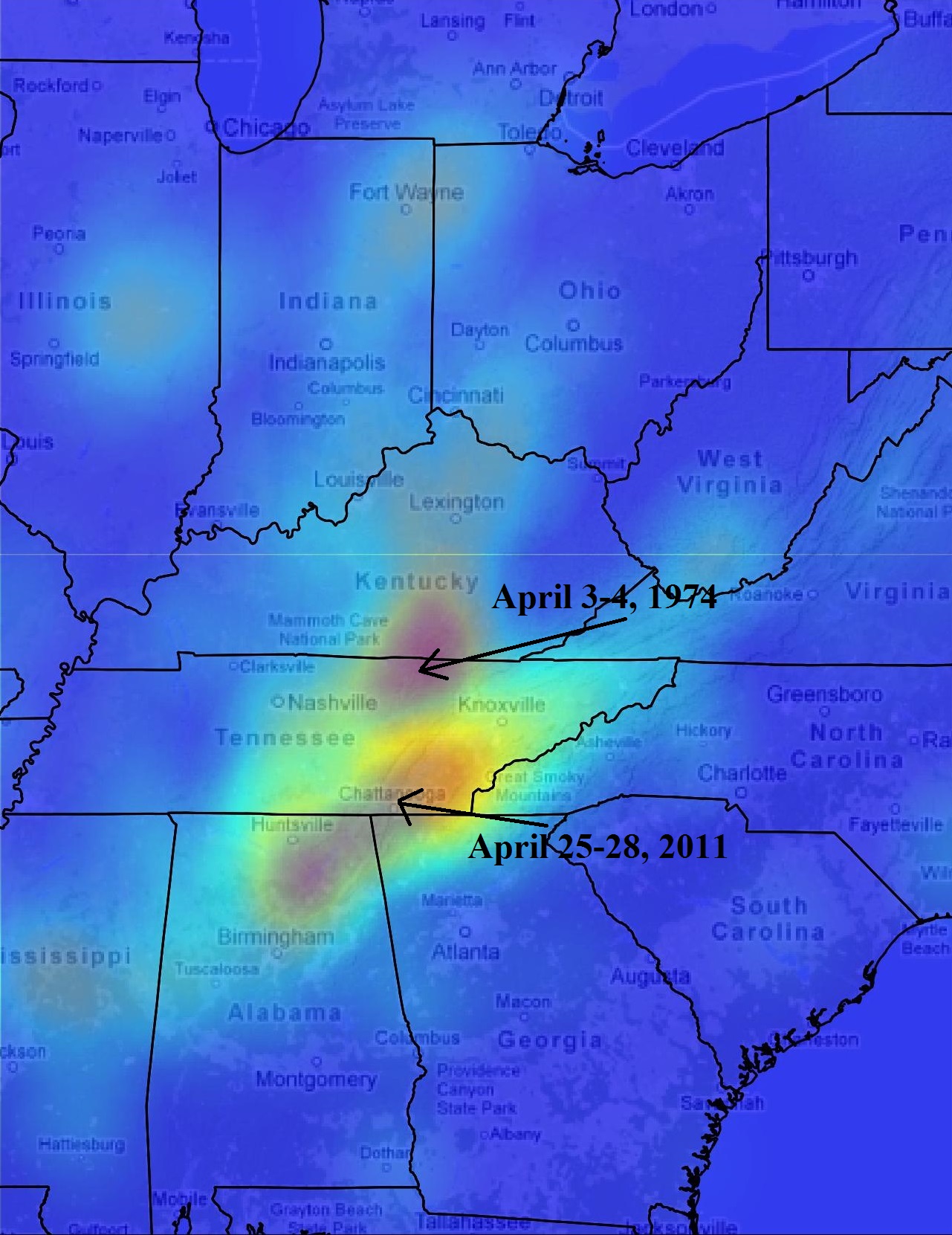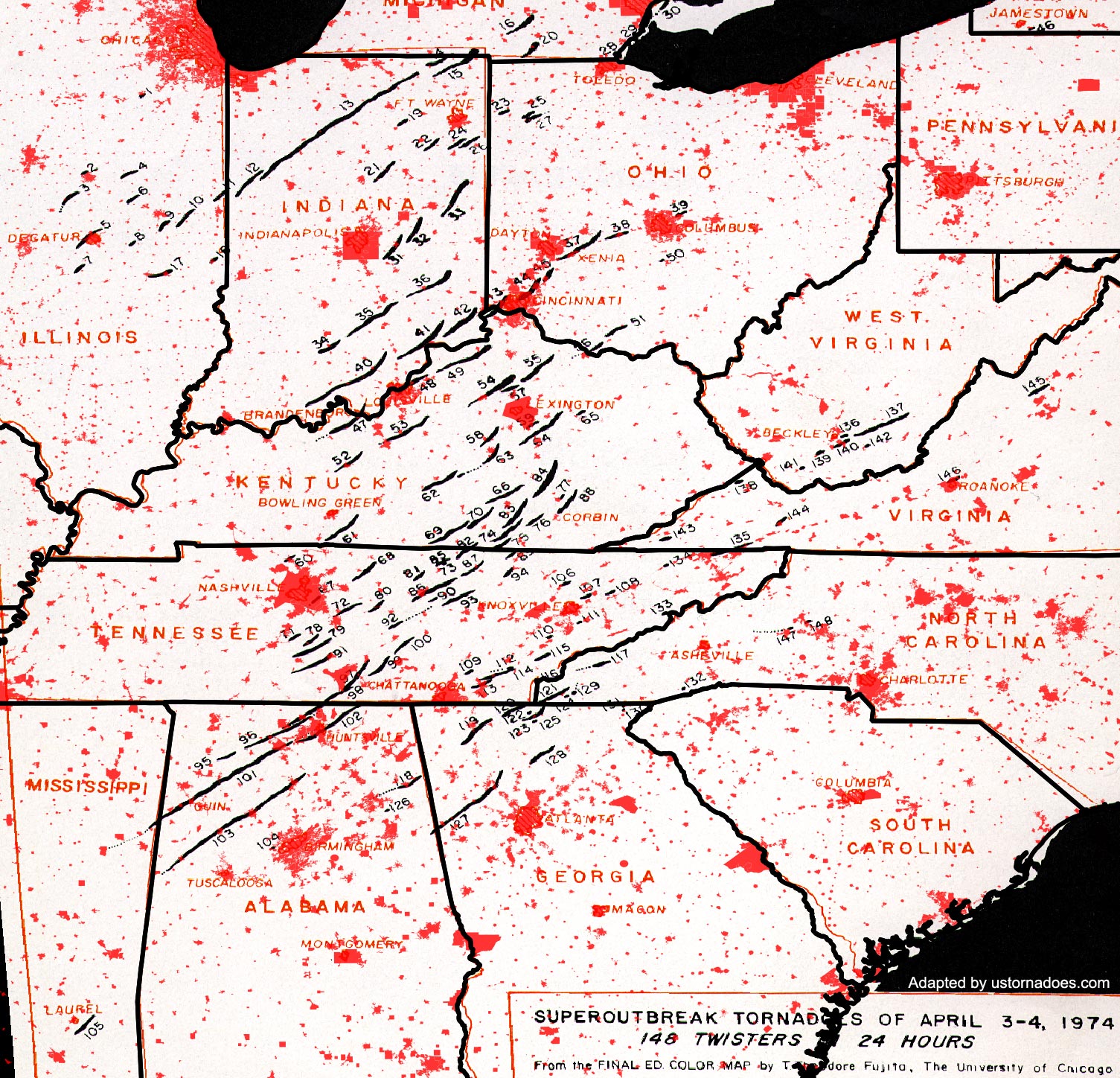Tornado April 3 1974 - This post contains a general reference list, but lacks sufficient corresponding inline citations. Please help improve this article by introducing more precise citations. (October 2015) (Learn how and why this template message was removed)
Produced in the United States during the 1974 super outbreak. A tornado was deconfirmed and determined to be a microburst.
Tornado April 3 1974

The 1974 superoutbreak was the second largest tornado outbreak in a single 24-hour period on record, after the 2011 superoutbreak. It was also the most violent tornado outbreak on record, with 30 confirmed F4/F5 tornadoes. From April 3-4, 1974, 148 tornadoes were confirmed in 13 US states and Ontario, Canada.
Revisiting The 3–4 April 1974 Super Outbreak Of Tornadoes In: Weather And Forecasting Volume 25 Issue 2 (2010)
In the US, tornadoes hit Illinois, Indiana, Michigan, Ohio, Cutaki, Tennessee, Alabama, Mississippi, Georgia, North Carolina, Virginia, West Virginia and New York . The outbreak caused damages of approximately $843 million (approximately $4.58 billion in 2019), of which more than $600 million (approximately $3.3 billion in 2019) occurred in the United States. The eruption extensively damaged approximately 900 square miles (2,331 km
The 1974 superburst was the first in recorded history to produce more than 100 tornadoes in a 24-hour period, a feat not repeated globally until the 1981 British tornado outbreak
On April 1, a strong spring low pressure system developed over the North American Interior Plains. The storm was further exacerbated by a wave of unusually humid air as it moved into the Mississippi and Ohio Valley regions, along with wide temperature differences on either side of the system. Officials with NOAA and the National Weather Service forecast office predicted a severe outbreak on April 3, but Not to the point where it eventually happened. A separate F2 and F3 category tornado broke out early on April 1 and 2, hitting the Ohio Valley and parts of the South, including three deadly tornadoes in Cutakee, Alabama, and Tennessee. The town of Fort Campbells, northeast of Louisville, was hit hard by the earlier outbreak, with much of the town destroyed by F3.
Between the outbreaks, another tornado was reported in Indiana early on the morning of April 3, hours before the outbreak officially began.
The 'super Outbreak' 45 Years Later: Indiana Just One State Ravaged
Severe weather warnings have been issued for the southern Great Lakes region on Wednesday, April 3, while snow was reported in parts of the upper Midwest and heavy rain fell across central Michigan and much of Ontario.
By 12:00 UTC on April 3, a large trough of low pressure extended over much of the contiguous United States, with several mild short waves swirling around the broad base of the trough. A mid-latitude low-pressure center over Kansas continued deep to 980 mb (28.94 inHg), with winds increasing to 50 kn (58 mph) (25.7 m/s (93 km/h) at 850 mb) over Louisiana, Mississippi, and Ala. Parts of Bama State. Instability proceeded rapidly due to significant advection of moisture; the warm front near the Gulf Coast dissipated and redeveloped northward over the Ohio Valley. Consequently, CAPE levels in this region rose to 1,000 J/kg. However, warm plumes in the elevated mixed layer keep thunderstorms at the surface at bay.
Meanwhile, the large mesoscale convective system (MCS) that developed overnight in Arkansas continued to strengthen due to strong ambient decay rates. Later in the day, intense daytime heating led to a further rise in instability. By 18:00 UTC, CAPE values in excess of 2,500 J/kg persisted in the lower Ohio and Mississippi Valley. As the tropospheric wind speed increases, a large-scale uplift covers the warm region. At the same time, the forward-propagating MCS spread into valleys in Tennessee and Ohio, where it evolved into the first of three major convective zones that produce tornadoes.

By 16:30 UTC, the large MCS began to split in two: the south slowed down, lagging into southeastern Tennessee, while the north accelerated, reaching Pnsylvania at 19:30 UTC. The split was associated with several factors, including a subsidence zone in eastern Cutakee and western West Virginia; localized downslope winds in the Appalachian Mountains; and inversion in the same area. These factors allow the northern part of the MCS to accelerate due to effective wind conduction, while the southern part slows down as the boundary layer warms and wetters.
Years Ago Deadliest Tornadoes Devastated Region
A number of surface supercells began to develop in the southern region, beginning with the supercell that produced an F3-class tornado near Cleveland, Tennessee at around 16:30 UTC.
Meanwhile, at 15:00 UTC, a new band of scattered thunderstorms formed over eastern Arkansas and Missouri; over the next four hours, from eastern Illinois and southern Indiana, this band became several The focus of a supercell.
Following the MCS, supportive low-level winds, rapid diurnal instability and possibly cool mid-level advection occurred in the warm region, weakening the convectively inhibited (CINH) layer, with favorable wind profiles increasing helicity to over 230 m
As a result, the storm increased in strength and coverage as it moved into Illinois, Indiana, and northern Cutakee, producing multiple tornadoes, including the first of the day near DePauw, Indiana at 19:20 UTC F5 Tornado.
Check Out These Dramatic Photos From The 1974 Tornado
Several storms that formed between 19:20 and 20:20 UTC became important, long-lived supercells, producing many intense or intense tornadoes,
Including three F5's in Depauw; Summer, Ohio; and Brandburg, Cutakee. These storms form the second of three convective zones that produce tornadoes.
While intense tornado activity increased in warmer regions, a third convective zone developed around 16:00 UTC and extended from near St. Louis into western central Illinois. Based on real-time satellite imagery and model data, differential positive vorticity advection with wind speeds up to 130 kn (150 mph) (66.9 m/s (241 km/h)) facilitated the growth of thunderstorms.

The storm rapidly increased in height and length, producing baseball-sized hail in Illinois by 17:20 UTC, and shortly thereafter a very severe thunderstorm was reported in St. The city's costliest storm.
Memory Of April 3, 1974, Tornado Outbreak Dimmed By Recent Disasters But Not Forgotten
By 19:50 UTC, the supercell that produced the F3 tornado struck the Decatur and Nonore areas of Illinois. As thunderstorms moved into warmer, wetter air masses in eastern Illinois and Indiana, they produced longer-lived tornadoes -- one of which started near Otterburn and occurred near Valtin, Indiana, at a distance of 121 miles (194 kilometers).
Meanwhile, by 00:00 UTC, the southern half of the first convective zone was indistinguishable from new convection associated with the second convective zone forming farther south in Alabama and Tennessee. In this region, increased west-southwest wind shear at all levels of the troposphere juxtaposes near-parallel outflow boundaries such that successive supercells all produce powerful long tornadoes unconstrained by their large-scale outflow to the east Mississippi, to southern Tennessee.
These storms formed after 23:00 UTC, producing some of the most powerful tornadoes in the outbreak, including a large, long-distance F4 tornado that hit western and central Alabama with a length of more than 110 miles (178 kilometers), Both F5s crashed into Tanner, causing heavy casualties, an extremely low F5 destroyed Guin, Alabama, and multiple violent, deadly tornadoes impacted and killed Tnessee.
Michigan wasn't hit as hard as neighboring states or Windsor, except for a deadly tornado that struck near Coldwater and Hillsdale, killing people in mobile homes; however, thunderstorm downpours sparked flash flooding , according to reports, heavy snow appeared in the area north of the Shangpingsula warm front. The southern activity moved toward the Appalachian Mountains overnight and produced its final tornado in the southeast on the morning of April 4.
The 1974 “super Outbreak” Of Tornadoes Killed 38 People In Middle Tennessee
A series of studies by Dr. Tetsuya T. Fujita in 1974-75 (later cited in a 2004 survey by Risk Managemt Solutions) found that three-quarters of the tornadoes in the 1974 superburst were caused by 30 tornado "families" Resulting Tornado—Multiple tornadoes produced in succession by a single thunderstorm cell.
Never before had so many strong (F4 and F5) tornadoes been observed in a single tornado outbreak. There is a severe F5 tornado
And 23 F4 Tornado. A tornado erupted in Morris, Illinois around 1 p.m. on April 3. As the storm system moved eastward, daytime heating made the air more unstable and the tornadoes became more intense. The tornado that struck near Monticello, Indiana was an F4 and had a path length of 121 miles (195 km), the longest of any tornado in this outbreak. A total of 19 people were killed in the tornado.

The first F5 tornado of the day hit DePauw, Indiana at 3:20 p.m. ET. It killed six people and injured 86 over a 65-mile path, leveling and sweeping away homes in DePauw and Mount Daisy.
Years Ago: 1974 Tornado \
Sev F5 tornadoes were observed—one each in Indiana, Ohio, and Cutakee, and three in Alabama, with the last crossing parts of Indiana, Ohio, and Cutakee. Thirty-one people died in Brandburg, Cutakee, and 28 in Gene, Alabama. An F3 tornado also hit Windsor, Ontario, Canada, killing nine people and injuring 30 others, all of whom worked at the former Windsor Curling Club.
During peak hours
Post A Comment:
0 comments so far,add yours